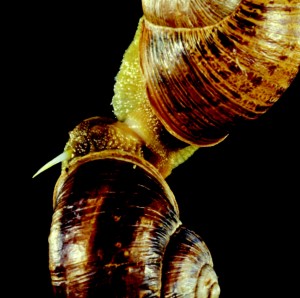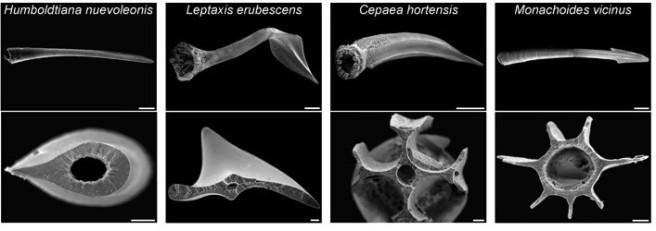
In classical mythology, Cupid carries two types of arrows: one with a sharp golden tip and one with a blunt tip made of lead. Those struck with the golden arrow are filled with uncontrollable desire while those wounded with the lead arrow are filled with revulsion. In these modern times, we humans are less likely to rely on a winged cherub carrying a quiver full of arrows to help us find love than on online dating sites and Tinder. That’s not to say that projectile weapon systems like the bow and arrow have become obsolete in affairs of the heart. Some species of land snails shoot love darts at their mating partners to increase their reproductive success.
As violent as it sounds, stabbing their mating partner with a love dart improves the likelihood that a snail will father offspring. These sharp and pointy darts are made of a crystalline form of calcium carbonate called aragonite and coated with mucus. If the dart hits its target, chemicals in the mucus coating are released into the recipient snail’s blood stream. These chemicals serve as signals that trick the female reproductive organs to divert the shooter’s sperm away from the sperm digesting organs and into the sperm storage organs where they can fertilize eggs later. While love darts are known to carry clear benefits for the shooter, not a lot is known about how being hit by a love dart affects the recipient. For the first time, scientists have experimentally studied the costs of this violent and traumatic behaviour to the individual being stabbed.
To study the effects of love dart stabbings on a snail’s ability to survive and reproduce, Drs. Kazuki Kimura and Satoshi Chiba at Tohoku University in Japan set up two groups of snails: one group mated with love dart-shooting partners while the other group mated with virgin snails that do not form love darts. Like a long series of blind dates, snails in both groups were mated with a different, randomly selected partner each week for four weeks. At the end of the four weeks, the snails were placed in individual pots and monitored until they died.

The researchers were specifically interested in whether being stabbed by love darts affected the longevity and reproductive rate of the snails. They found that over their entire lifetime, snails that had been stabbed by love darts laid fewer eggs than snails that had not been stabbed (~95 vs ~130). Snails in the love dart group also died roughly ten days earlier than snails in the no stabbing group. These results indicate that being the victim of a love dart stabbing decreases both the survival and reproductive rate, leading to an overall decrease in fitness.
That love darts simultaneously increase the reproductive success of the shooter and decrease the survival and reproductive success of the recipient presents an interesting situation. For you see, most land snails are hermaphrodites – they have both male and female reproductive organs. Every time a snail mates, it is at once both the shooter and the stabbing victim. Do the increased reproductive success of shooting a love dart offset the costs of being stabbed themselves? We don’t know. The first step in understanding the evolution of sexual conflicts is to determine the actual cost and benefits to both sides. Studies like this one provide important insights into what happens when a snail is stabbed by a love dart and show that in a snail’s world, getting hit by Cupid’s arrow is best avoided.
Reference:
Kimura, K., & Chiba, S. (2015). The direct cost of traumatic secretion transfer in hermaphroditic land snails: individuals stabbed with a love dart decrease lifetime fecundity Proceedings of the Royal Society B: Biological Sciences, 282 (1804), 20143063-20143063 DOI: 10.1098/rspb.2014.3063

Very cool! Thanks for sharing your summary of this neat paper!
LikeLike
Thanks! As soon as I saw this paper, I knew I had to write about it. It’s just too cool to pass up.
LikeLike
I had no idea!
LikeLike
Me neither! Those darts are pretty darn sharp!
LikeLike